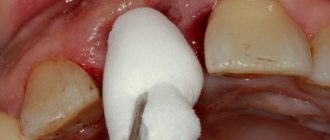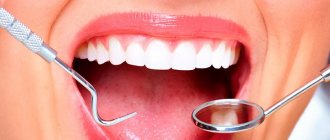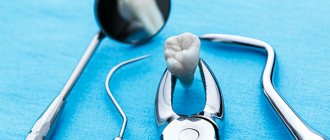Duration of engraftment Causes of rejection Signs of rejection Contraindications to implantation Types of implantation Engraftment above and below What to do with mobility?
Care after surgery Implantation is the only prosthetic method that restores the functionality of the entire tooth, and not just its crown part. A dental implant is a multicomponent structure made of biocompatible material (titanium and its alloys), introduced into the jaw bone to replace a missing tooth unit. It fully replaces a natural tooth, taking over all its functions. Those who decide to undergo implantation are usually interested in how dental implants take root, how long it will take, and what problems may arise.
The viability of an artificial root depends not only on the choice of its type, shape, and size according to the parameters of the jaw bone. But also on the general state of health, correct installation of the implant, compliance with the doctor’s instructions in the postoperative period.
How long do dental implants take to take root?
The process of fusion of an implant with bone is called osseointegration. It goes like this:
- In the first 30 days
after the introduction of the artificial root, trabeculae of spongy substance begin to actively form around it, forming the skeleton of bone tissue. During this period, the tissue around the implant is soft, loose, and easily injured. - about 3 months
, a soft, loose spongy structure forms into dense lamellar bone, firmly holding the titanium root. During this period, the implant can already be loaded with a prosthesis. - Complete fusion with the jaw bone occurs after 1.5 years
.
The survival rate of dental implants is influenced by various factors - from the implantation protocol used to the type of jaw the structure is integrated into (lower or upper). After implantation, enough time must pass for the bone tissue to “accept” the artificial root and begin to grow around it, ensuring a stable, strong fixation.
Price of the procedure and other nuances
In each case, removal of a dental implant is considered in conjunction with solving related problems, an individual course of treatment is provided, so the final cost is calculated for each client. It is possible to pay for procedures in installments.
The least number of complications arise when a new tooth is implanted on the same day as the old implant is removed. There is no need to re-injure tissue or postpone the decision. Timely restoration of the row is beautiful and important. There is no additional atrophy of bones or gums, healing occurs quickly.
Experience shows: removal of implants and their replacement is a procedure that preserves the integrity of the dentition, optimal functioning of the gastrointestinal tract and increases the patient’s self-esteem during rehabilitation.
Why an implant may not take root
The worst thing that frightens patients is the risk of rejection of the structure. Thanks to modern protocols and materials, the implant survival rate is as high as possible ( 97-98%
). When installing original implant systems Astra Tech, Nobel Biocare, ROOTT, Straumann, rejection rates do not exceed 0.2-0.5%, that is, the survival rate is almost one hundred percent.
When asked why dental implants do not take root, the doctor will answer after examination and diagnosis. But the patient needs to be more careful, not ignore warning signs, and immediately contact an implantologist. The success of the operation and engraftment is influenced by:
- health status;
- quality of preparation for surgery;
- choice of implants;
- implantation protocol;
- correctly calculated prosthesis design;
- careful adherence to medical recommendations in the postoperative period.
Attention to all of the above points reduces the likelihood of design rejection to zero. Typically, engraftment of a titanium root with classic two-stage implantation takes at least 3 months
. After the structure has fused with the bone, an abutment is fixed on them, and an artificial crown or prosthesis is placed on top. With express implantation or basal complex, engraftment proceeds faster. The implanted roots are loaded with a temporary prosthesis 1-3 days after surgery.
What determines the success of osseointegration
Several factors influence the success of engraftment:
- Proper preparation and planning.
- Patient's health status.
- Use of high-quality implants.
- Selecting an implantation method that is appropriate for the clinical situation.
- Correct calculation of the prosthesis design.
- Compliance with recommendations after implantation.
Attentive attention to each point ensures engraftment without complications.
Risks at the diagnostic and preparation stage
In order for engraftment to proceed without problems, it is important to eliminate risks at the stage of preparation for implantation:
- An examination is carried out for general somatic diseases to identify contraindications to surgery.
- The doctor diagnoses diseases of the oral cavity that are in the acute stage, paying close attention to the future site of implantation and surrounding tissues. The oral cavity is sanitized, adjacent teeth are treated, and plaque and stone are removed.
- An implant treatment plan is drawn up, and recommendations are given to the patient on the rules of preparation for the operation.
- 3D computer modeling helps to choose the shape and size of the implant. This is necessary so that the design fits the patient’s bone characteristics and does not reject it.
Patient's health status
Successful implantation is impossible in case of serious diseases that can cause implant rejection. The main contraindications for which implantation is strictly prohibited:
- malignant tumors;
- decompensated diabetes mellitus;
- blood clotting disorder;
- mental illness;
- tuberculosis;
- pathological diseases of the cardiovascular system;
- risk of heart attack or cardiac arrest;
- disruption of the immune system;
- thyroid diseases.
The patient should not hide his condition and agree to the procedure without prior diagnosis. In addition, diagnostics will help identify hidden diseases that you may not be aware of. Therefore, before the procedure, the doctor collects anamnesis and prescribes tomography, blood tests, and ECG for patients at risk.
Main reasons for rejection
- Peri-implantitis
- the tissues around the implant become inflamed for various reasons: due to undetected contraindications to implantation, poor preparation of the oral cavity for surgery (untreated caries, active gum disease, etc.), violations of the installation protocol, failure to comply with medical instructions after surgery . - Features of the structure of the jawbone
- in loose, porous bone, even with sufficient volume, the titanium structure will not hold. To avoid problems, the bone is additionally strengthened with special materials. - Intolerance to the implant material
- although titanium and its alloys are biocompatible with bone structures, allergies sometimes develop. This usually happens if implantation systems of dubious quality that contain various harmful impurities are used. - Systemic diseases
- endocrine, immune, cardiovascular pathologies, oncological processes significantly increase the risk of artificial root rejection. - Incorrect osseointegration
- when installing low-quality systems, their components come into contact with the jaw structures and provoke the formation of fibrous tissue rather than bone. As a result, instead of strong bone tissue, a connective tissue capsule is formed around the implant, which cannot hold the structure, and it falls out.
The network of RUTT clinics in Moscow uses reliable, proven implantation systems. Before surgery, patients undergo a comprehensive examination to assess the characteristics of the dental system and contraindications. Implantation is performed after all risks have been eliminated, so the listed points are kept to a minimum.
The role of the doctor in choosing a treatment method
Often, already at the first consultation, the patient categorically declares: “I need an implant!” It sounds so confident that it seems that only the lack of appropriate tools is keeping the patient from doing it himself.
Before receiving the right to treat patients, a doctor studies for 6 years, then for 2 years he can undergo highly specialized training. Every 5 years he goes to improve his qualifications, but in fact he studies all his life, constantly gaining new experience, skills and knowledge. What can be concluded? Only a doctor can draw up an optimal rehabilitation plan and carry out the necessary manipulations.
Before starting treatment, a comprehensive clinical and radiological examination is carried out, and if necessary, the patient is referred for consultations to doctors of related specialties. Not only the extent of the dental defect is assessed, but also the condition of each remaining tooth, the quantity and quality of bone tissue, and the presence and severity of the patient’s general diseases. Only then will it be possible to make a diagnosis and formulate a treatment plan. Of course, the patient should be fully informed about both the treatment plan and alternative methods.
In conclusion, we would like to advise patients who have not decided on the choice of treatment method and who have no serious contraindications to pay attention to dental implants.
Signs of implant failure
Swelling, pain, slight fever, bleeding gums 3-5 days after implantation
– a normal reaction to intervention. Within a week, these symptoms disappear. If symptoms persist longer than the specified time and increase, you should immediately contact an implantologist.
Signs of peri-implantitis on x-ray
Signs of rejection may appear not only during the rehabilitation period, but also later. How to understand that the implant is not taking root:
- severe swelling, hyperemia of the mucous membrane, persisting longer than 5 days after the intervention;
- acute pain, aggravated by pressure on the gum;
- the appearance of a bad odor;
- purulent discharge;
- bleeding for more than 2 days, ichor for more than 7 days;
- temperature 38°C and above, not reduced by antipyretics;
- implant mobility, its loss.
Sometimes there are no visual signs of rejection, the artificial root simply falls out. As a rule, if the implanted root has not been rejected within a month, osseointegration proceeds normally. But it happens when the artificial root is rejected at a later stage, after the installation of the prosthesis. The causes may be previous viral diseases, acquired after implantation, immune diseases, or injuries.
Myth 2. “It's difficult. There is a risk of running into a non-professional, and then the implant will be rejected.”
Cases of rejection are extremely rare. Among implants in the middle price segment, successful engraftment occurs in 95-97.5% of cases, in the premium implant segment in 98-99% of cases.
Engraftment is affected by the patient’s compliance with the doctor’s strict recommendations.
Examples:
- Irregular brushing of teeth leads to the accumulation of plaque in the cervical area, which provokes inflammation of the gums. It spreads in the mouth, affecting the area where the implants are installed. The result is rejection.
- In addition to implanted teeth, the patient has prosthetic teeth, while the prosthesis “fits” poorly and constantly gradually injures the gums. This leads to reimlantitis.
- The patient forgot to tell the doctor that he was being treated at the cancer center. As a result, a course of radiation therapy leads to implant rejection.
There are many situations when a patient provokes (or does not prevent) the development of conditions for rejection. And the chances of this happening are higher than the chance of meeting with an amateur implantologist.
Oksana Melnikova, Moscow
“I was given an implant a long time ago, about 7 years ago, and it took root so successfully that I completely stopped distinguishing where I have real teeth and where I have artificial ones. Last year I did a hardware air flow cleaning, I liked the result, I promised myself to do it regularly. On one of my visits, I was “entrusted” to a young girl, apparently a trainee or intern, whatever they call it. She went over my gums thoroughly, so much so that the next morning they were swollen and itchy. Inflammation of the gums did not go away quickly (early spring, vitamin deficiency, all that), plus I didn’t start treating them right away, I just bought a soft brush and toothpaste for the gums. I thought it would pass. It did not pass. While I was getting ready to see the periodontist, I felt something was wrong; the implanted tooth on the lower jaw began to MOVE. After a month of futile attempts to save the implant, it was removed with pieces of overgrown bone. Simply creepy! Now I have had German bone material inserted, I’m waiting for it to take root and I will restore the tooth again. It’s a shame that there is no one to blame but yourself.”
Contraindications to implantation
Contraindications to the procedure are divided into absolute and relative. Absolute conditions in which the operation is impossible include:
- oncology in the active phase;
- diabetes mellitus in the decompensated stage;
- mental disorders;
- acute tuberculosis;
- blood clotting pathologies;
- severe cardiovascular pathologies;
- a heart attack or stroke suffered less than 6 months ago;
- allergy to anesthetics, implant material;
- connective tissue diseases.
Relative restrictions:
- age under 18 years;
- poor oral hygiene;
- bad habits (alcoholism, smoking abuse);
- pregnancy, actuation;
- systemic diseases during exacerbation;
- infectious and inflammatory processes.
The ability to combine installation protocols significantly reduces the list of contraindications, allowing you to solve almost any clinical problem. One-stage protocols make it possible to carry out implantation in patients with HIV, periodontitis, periodontal disease, endocrine pathologies, hepatitis B, C, and other complex diseases that were previously considered an absolute contraindication to implantation.
Patients with periodontal pathologies are interested in the question of whether implants survive periodontal disease.
. One-stage protocols combine different models of implants (compression, basal). They have high rates of resistance immediately after surgery. Basal models are installed not in spongy bone, but in deeper bone sections - basal, bicortical, not subject to atrophy. The inclined position increases the area of contact between the implants and the bone and accelerates osseointegration.
A complete denture will not adhere well to the implants and some of them will be overloaded, is that true?
With the exception of the situations that we described above, four implants are quite enough to support a full-fledged denture of 10-12 crowns per row. Implants in the lateral zone are installed at an angle, thus using a larger area of the jaw bone.
In addition, the prosthesis has a metal frame (except for cases where the adaptive prosthesis is frameless and is placed on the day of the implantation surgery, that is, according to the “teeth in 1 day” protocol). The frame reliably connects and stabilizes the implants. There can be no rebound effect - due to the presence of a strong base inside the prosthesis, as well as planning the process of placing implants taking into account future prosthetics. In addition, we do not chew with only one extreme tooth - all side elements are used for this: the load is distributed evenly.
An example of creating a real frame for all-on-4 prosthetics and a model of two complete dentures with 12 crowns for each row
At the preparation stage, at least two doctors are involved in the process - an implant surgeon and an orthopedic dentist, who work closely together. And if the prosthesis is uncomfortable, does not normalize the bite, dangles, and so on, then this means that the surgeon and the orthopedist did not coordinate their actions, the prosthesis was not worked out before the start of treatment, and the implants were placed without further understanding of how the prosthesis would be attached to them .
Thanks to the NobelClinician software, which is used to plan all stages of all-on-4 implantation using the Nobel Biocare brand, the doctor analyzes the quality and quantity of bone in volume, selects the placement points of the implants, the dimensions of the structures, and their exact angle of inclination. Next, the entire “implant-prosthesis” structure is modeled, and multi-unit abutments with the appropriate angle on which the prosthesis will be attached are selected. Then it is calculated how the chewing load will be distributed: the bite parameters are taken, standard load parameters are entered into the program, and then the chewing process is simulated. Thus, the possibility of excessive load on the prosthesis and its breakage is completely eliminated.
We guarantee high results! We use only original implants and prosthetics for them. We do not skimp on your health and achieve lasting treatment results that will last for many years.
Free consultation
How long does it take for an implant to take root?
Osseointegration is influenced by the type of implantation system (type, shape, coating, type of thread, connection to the abutment), and the method of its installation. The doctor chooses the type of implants and implantation method according to the clinical picture. One- and two-stage technologies are used:
- Classical implantation (two-stage protocol) – two-component, root-shaped models are used. The root part of the implant is installed in the jaw, closed with a plug and sutured. After osseointegration of the titanium structure with the bone, the abutment and crown are fixed. Engraftment lasts 2-4 months (how the body reacts).
- One-stage methods with immediate loading - the prosthesis is attached to the implants after implantation (within 72 hours). Instant loading with the prosthesis stimulates bone formation around the implant, reducing the time of osseointegration. In the protocol, one-component models are more often used, in which the root-shaped part and the abutment form a single whole.
- Single-stage implantation - a titanium root is installed in the tooth socket immediately after its removal. The blood clot triggers the synthesis of osteoblasts, which accelerates engraftment. But this method is possible if there is sufficient volume and quality of the jaw bone, and the absence of even the slightest signs of inflammation. The implant is loaded with a prosthesis after complete engraftment.
With single-stage implantation, it is possible to install a temporary crown immediately after implantation
. But in this case, the structure is removed from the chewing process (the crown is made in height below the general row of teeth).
Which clinic to choose
You can get dental implantation in Moscow at one of the ROOTT MCDI clinics. Installation of a two-stage ROOT implant (Switzerland) at the Moscow Center for Dental Implantology will cost 32,000 rubles. (excluding the cost of the crown), express implantation ROOTT – 44,000 rubles. (together with a temporary crown). You can learn more about the implantation technologies used in order to choose the most preferable option and have an idea of what to be prepared for at a free consultation with an implantologist. Appointments can be made by phone or online.
Modern dentistry offers a number of methods that give patients a chance to regain their beautiful smile. Every year, implant treatment becomes more popular and accessible.
In some cases, when it is necessary to remove a patient's own tooth, most often in the case of front teeth, dentists have the option of inserting an implant into the socket immediately after extraction. Then a “temporary” crown can be installed, thanks to which the patient maintains dental aesthetics, speech and chewing function. After about three months, the temporary crown is replaced with a permanent one, made by a technician in a laboratory. Single-stage implants themselves are slightly different in price from those that are loaded with delayed loading.
You can get advice from experienced specialists about dental implantation in the smile zone in the capital’s dental clinics:
| Clinic address | Clinic | Price |
| Dentistry ROOTT |
|
| Moscow, Kolpachny lane, 6, building 4. | Dentistry Sandora |
|
| Dentistry Prosmail.RU |
|
| Moscow, metro station "Butyrskaya", Rustaveli Street, building 15 | Dental Clinic Dention |
|
| Moscow, metro station Barrikadnaya st. Zoologicheskaya, 2, under. 9 | Dentistry DENTAL DREAM |
|
| Moscow, Zvenigorodskoye sh., 7 | Dentistry Implant Expert | Nobel implantation, USA, from 50,000 rubles, Astra Tech implantation, Sweden from 47,200 rubles, OSSTEM Korea - 27,000 rubles |
| Moscow, Bolshoi Sergievsky lane, 5 | Dentistry Viva-dent | Dental implantation depending on complexity: 31,000 - 41,000 rubles per 1 tooth |
| Moscow, st. Molodtsova, 2a | Family discount dentistry | Implantation is carried out using various systems - Astra Tech (Sweden), Ankylos Densply (Germany), Dentium (Korea), the price for 1 restored tooth is from 30,000 rubles. |
| Moscow, Paveletskaya sq., 1 | Dental Clinic Denta VIP | Implantation of the IMPLA system (Germany), OSSTEM (Korea) - from 36,000 rubles. Astra Tech (Sweden) – from 45,000 rubles. |
| Moscow, st. Lyublinskaya, 161 | Dentistry PRESIDENT |
|
Dental implants are the latest technologies that provide exceptional comfort of use. Patients who have lost their front teeth due to an accident, tooth decay, or other diseases can enjoy the ability to function normally and smile without fear, without discomfort, thanks to dental implants. The most modern method of replacing missing teeth is implantation.
Dental implants are placed when we lose our natural teeth. Most often, the decision to replace missing front teeth is made for aesthetic reasons. It's no secret that missing teeth can lead to changes in our appearance, or rather, facial features. You can see the appearance of your cheeks, mouth and nose change. Wrinkles appear faster in the middle part of the face, which makes us feel unattractive.
However, it is worth remembering that from a medical point of view, the replacement of missing teeth, both front and back, is very important. The absence of teeth disrupts the functioning of the chewing system, which over time affects both aesthetics and our health. The absence of molars causes improper grinding of food, which leads to the development of diseases of the digestive system, such as peptic ulcers or increased stomach acidity.
What to do if the implant is mobile and does not take root
If any sign of rejection appears, you should contact the implantologist who performed the operation. Based on the diagnostic results, it will be clear whether the implant can be saved with conservative therapy or whether it will need to be removed. In most situations, after eliminating the inflammatory process and restoring the jaw tissue, re-installation of the implant is possible. In the absence of contraindications, reinstallation is carried out after 1-2 months. If the bone tissue is severely damaged due to rejection, surgery to build it up will first be required.
Myth 4. “Implantation is done under general anesthesia, causing harm to the heart”
In most cases, there are no indications for general anesthesia, and patients are implanted under local anesthesia. At the same time, they are conscious, observe and partially control the situation, and respond to the doctor’s requests.
The myth about the dangers of general anesthesia for the heart has been entrenched in the mind since the times of Soviet medicine, when potent and harmful drugs were used for anesthesia. Pharmacology has made great strides forward, anesthesia has become effective and less dangerous. Although it puts a short-term and harmless load on the kidneys and liver.
Igor Bondarev, St. Petersburg
“The global nature of my dental problems is largely explained by the fact that I tried to avoid dentists all my life. Naturally, when there are 9 diseased teeth left in the oral cavity, and not a single healthy one, it’s time to reconsider the situation. I mentally understood that I needed to do implantation, but at the same time, the fear of any medical manipulations held me back. Having assessed the scale of the disaster, the doctor offered me general anesthesia. And so they did. The operation lasted more than an hour and a half - at the bottom they installed a common bridge on implants, but at the top they installed 4 separate classic ones, in general - they tinkered with me. I’m glad I wasn’t “present” at this!”
Is it possible to secure a prosthesis with only 10 crowns on 4 implants?
When using all-on-4 prosthetics, the length of the denture is 12 crowns (that is, 24 teeth on two jaws, normally there should be 28 living teeth). But it all depends on the situation and on the materials that will be used to make the prostheses. In the original Nobel Biocare protocol, prosthetics are performed up to the 6th tooth (adaptation period), which makes it possible to restore up to 90% of chewing function. With permanent prosthetics, chewing function is restored by 100%.
In rare cases, the doctor may actually decide to place a prosthesis consisting of only 10 crowns - but this is rare. And such a prosthesis is placed only on a temporary basis.
An example of an adaptive prosthesis consisting of 12 crowns on four Nobel implants. NobelZygoma zygomatic models were additionally used on the upper jaw
In general, this amount is more than enough for full chewing and even more so for creating a beautiful smile. If the patient insists on installing a prosthesis consisting of 14 crowns (up to 7 teeth), then several more supports will be required - for example, an all-on-6 protocol should be used. But it is important to remember that a solution with four implants is cheaper than with six, which is what accounts for its greater popularity. At the same time, there are no obvious functional differences in prostheses made of 12 or 14 crowns - you can eat fully with both, it’s just that when up to 6 teeth are restored, not 100%, but 90% of the chewing function is restored.











